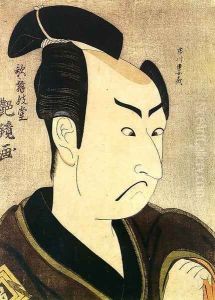Kabukido Enkyo Paintings
Kabukido Enkyo, born in 1749 and deceased in 1803, was a Japanese artist known for his Ukiyo-e style woodblock prints. Enkyo's work is lesser-known compared to the great masters of his time like Katsushika Hokusai or Utagawa Hiroshige, but he contributed to the rich tradition of Japanese printmaking during the Edo period.
Enkyo's life coincided with a period in Japan where the Ukiyo-e genre flourished, catering primarily to the merchant class, portraying subjects ranging from sumo wrestlers and kabuki actors to landscapes and scenes from folklore. Enkyo's works often depicted kabuki actors, hence the prefix 'Kabukido' in his name, which suggests a specialization or a particular affinity with the kabuki theatre. The term 'do' in his name translates to 'hall' or 'mansion,' possibly alluding to a place where such performances were held or a metaphorical space where he 'resided' artistically.
There is limited information about Kabukido Enkyo's personal life and training, which is not uncommon for artists of this period. Many Ukiyo-e artists belonged to different schools or were apprentices under more prominent artists before establishing their own style and reputation. It is during Enkyo's lifetime that full-color printing (nishiki-e) was developed, which allowed Ukiyo-e artists to produce prints with a wide range of colors and intricate designs.
Despite the scarcity of biographical details, Enkyo's prints remain as a testament to his skill and contribution to the world of Ukiyo-e. His depictions of kabuki actors are characterized by expressive poses and vibrant colors, capturing the drama and emotion of the theatrical performances of his time. After his death in 1803, Kabukido Enkyo's works continued to be appreciated by collectors and scholars of Japanese art, contributing to the understanding and appreciation of Ukiyo-e prints as significant cultural and historical artifacts.
